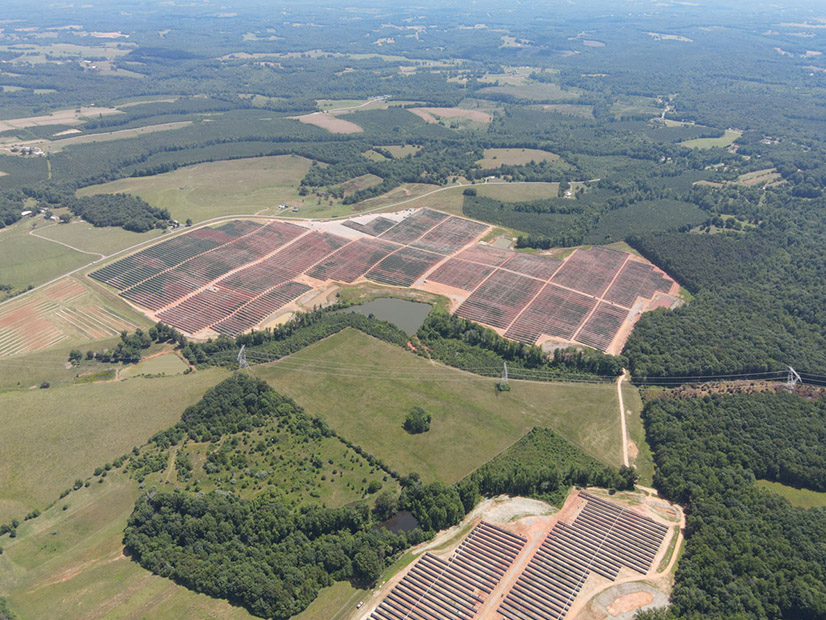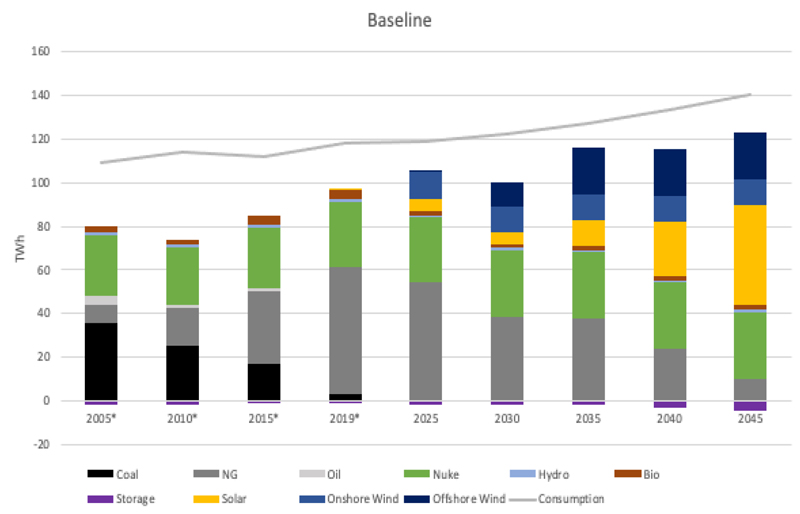
Governor-elect Glenn Youngkin (R) shook Virginia’s environmental and clean energy advocates Jan. 5 with his controversial nomination of Andrew Wheeler, who led EPA under President Donald Trump, to be Virginia’s next secretary of natural resources.
But when Youngkin takes office Saturday, he will be leading a state widely recognized as a Southern leader in the U.S. energy transition, with strong targets for grid decarbonization under the Virginia Clean Economy Act (VCEA).
Further, with a slim Democratic majority holding the line in the state Senate, Youngkin and the Republican majority in the House of Delegates will not be able to repeal the VCEA or take Virginia out of the Regional Greenhouse Gas Initiative (RGGI), as the governor-elect has vowed to do. Democratic lawmakers have also declared they will fight Wheeler’s nomination “tooth and nail.” (See Youngkin Taps Trump’s Former EPA Chief to Head Virginia DNR.)
Even putting the partisan state of play aside, the momentum of cleantech in Virginia may be hard to slow down, as demonstrated by a series of plans and reports announced in the runup to Youngkin’s inauguration.
On Dec. 30, Appalachian Power filed its 2022 renewable energy plan, as required by the VCEA, with modest commitments to add 294 MW of solar and 204 MW of wind to the utility’s generation mix over the next three years.
And on Jan. 1, the outgoing administration filed its VCEA-mandated report on the least-cost strategies for grid decarbonization, including a finding that the low cost of clean energy will outweigh any need for the state legislature to prohibit new fossil fuel plants. Dominion Energy also started the new year with a Jan. 7 ruling from the State Corporation Commission (SCC) giving it the go-ahead for the second phase of its grid modernization program, which includes preparing the utility’s distribution system for high levels of distributed energy resources.
Solar Grows, but Coal Stays
Appalachian’s new solar and wind power procurements were the top-line items in the company’s Jan. 4 announcement of its 2022 VCEA plan. The utility will acquire a 204-MW wind farm in Illinois and a 150-MW solar plant in Virginia; it will also sign power purchase agreements for three additional solar projects, totaling 89 MW, according to the plan, which will need approval from the SCC.
The utility “intends to meet its VCEA targets primarily through investments in solar, wind, energy storage and purchase of market renewable energy certificates,” it said. “By 2040, the company expects to add approximately 3,300 MW of solar, 2,600 MW of energy storage and nearly 3,000 MW onshore wind to its current portfolio of wind and hydro resources.”
Building out its renewable portfolio will provide near-term savings, according to Ismael Martinez Jr., resource planning manager for the utility’s parent company, American Electric Power (NASDAQ:AEP). In the 2022 plan submitted to the SCC, Martinez said the new solar would “help Appalachian avoid costs it would otherwise incur as a PJM participant, especially by helping the company to avoid purchasing energy from the PJM energy markets, which can be volatile.”
Solar can also be used as a distribution resource, Martinez said, to “reduce the company’s load during the PJM … coincident peak hours, thus providing a capacity obligation benefit by allowing the company to avoid an incremental purchase of capacity in the future.”
But reaching these and other VCEA goals could be challenging. The most recent figures on Appalachian’s generation mix, from September 2021, show that close to 65% of its power comes from coal and another 19% from natural gas, according to a company spokesperson. Most of that coal-fired power comes from two plants in West Virginia, which the utility intends to keep online through 2040, eventually replacing their combined 4,235 MW with carbon-free power.
If fossil fuel generation were to be used to replace the coal plants, it would be located out of state, the plan says.
Appalachian looked at the possibility of closing the coal plants by 2028, according to the plan. But in August the West Virginia Public Service Commission ordered the utility to make improvements at the two plants to bring them into compliance with federal wastewater regulations, which will allow them to stay online past 2028. Who will pay for these improvements has become a flash point since the SCC rejected Appalachian’s request to recover part of the costs from its Virginia customers, while the PSC has said West Virginia consumers may have to foot the bill for the upgrades on their own.
Andy Farmer, interim director of the SCC’s Division of Information Resources, said the commission has yet to schedule any hearings on Appalachian’s plan.
“Commission staff is reviewing the application to ensure that it is complete, and in a few weeks the SCC will issue a procedural order that provides opportunities for public comment and a schedule for hearings,” Farmer said.
Least-cost Path to 100% Clean Power
The VCEA report — compiled by the Natural and Historic Resources Department and Commerce and Trade Department, and submitted to the legislature on Jan. 1 — looks at the least-cost strategies for Virginia to reach a decarbonized grid by 2045. That goal can be achieved with existing technologies based on the VCEA’s renewable energy and energy efficiency standards and the emission reductions possible through RGGI, the report says.
The law calls for the state to add 16,100 MW of solar and onshore wind, along with 3,100 MW of energy storage. The solar industry alone could add tens of thousands of jobs to the state’s workforce as the sector grows from $1.3 billion to $8.1 billion in economic activity over the coming decades, numbers that underline the “economic strength of the clean energy sector,” the report says.

“The emerging/advanced/clean energy sector is already a significant share of the energy economy in the commonwealth and is only poised to grow — largely because of the VCEA and the policy certainty it provides,” the report says.
Perhaps with Youngkin in mind, the report also warns that “markets working to drive clean energy growth will be limited without policy to help drive that growth. Low-carbon energy technology is widely acknowledged as the cheapest source of new electricity capacity, but strong policy signals ensure that the market responds at a rate reflecting the pressing need to eliminate greenhouse gas emissions.”
Rolling back the VCEA “could send a negative signal to industries already investing in Virginia,” the report says, pointing to the state’s expanding offshore wind industry as a key example. The rapid development of the sector is being driven by the VCEA’s target of 5,200 MW of offshore projects by 2034.
At the same time, the report does not recommend that the legislature pass any laws prohibiting the permitting of new fossil fuel generation. Such resources will be needed in the near term for reliability and flexibility, and the clean energy and efficiency targets in the VCEA will provide a competitive advantage for solar, wind and storage, the report says.
It also anticipates that nuclear power, which currently generates just under a third of the state’s electricity, will continue to provide a significant portion of its power. Natural gas, while still in the mix in 2045, will have shifted from baseline to seasonal backup power. By 2040, the state will have retired all but 20% of its legacy fossil fuel plants, and almost all new generation will be solar, wind and storage, the report says.
DERs
With the SCC’s approval of the second phase of Dominion Energy’s (NYSE:D) grid modernization plan, the utility announced it will be investing $650 million this year and next for a range of distribution system improvements and upgrades, from the installation of 1.1 million smart meters to a management system for integrating DERs.
But the commission’s ruling also came with conditions that Dominion show the value of those investments. For example, the utility’s plans to spend $198.3 million on smart meters must also ensure the technology will be optimized to provide customer savings and demand-side flexibility. A time-of-use rate the utility has been piloting will be developed into a systemwide offering, along with the creation of an opt-in demand response program providing peak-time rebates.
Dominion’s request to spend $5.2 million on a DER management system drew opposition from commission staff, who argued that the utility’s distribution system can handle the relatively low levels of DERs now installed.
The company had also pitched for the investment as necessary to better leverage aggregated DERs for the PJM system in compliance with FERC Order 2222. Again, staff raised concerns, this time about the uncertainty surrounding the RTO’s compliance filing, and Dominion agreed to put a hold on system implementation until the filing is submitted and approved.

